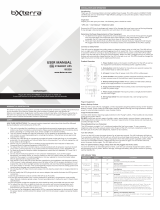
20
Instrucciones de Seguridad Importantes
CONSERVE ESTAS INSTRUCCIONES
Este manual contiene instrucciones importantes que deben seguirse durante la
instalación, operación y almacenamiento de este producto. La omisión en la
observancia de estas advertencias puede afectar la garantía.
Advertencias para la ubicación del UPS
• Tenga cuidado al levantar el UPS. Debido al peso considerable de todos los sistemas
UPS para instalación en rack, deben ayudar al menos dos personas para levantarlos e
instalarlos.
• Instale el UPS en interiores, alejado de humedad o calor excesivos, polvo o luz solar
directa.
• Para mejor rendimiento, la temperatura ambiente en proximidad al UPS debe estar entre
0° C y 40° C (entre 32° F y 104° F).
• Deje espacio adecuado alrededor del UPS para una ventilación apropiada. No obstruya
las ventilaciones o aberturas de los ventiladores.
• Al instalar el sistema UPS en una orientación de torre, asegúrese de que el panel de
LCD se encuentre en la aparte superior del UPS, no en la inferior.
• No instale la unidad con su panel frontal o posterior viendo hacia abajo (en cualquier
ángulo). Al instalarlo de esta manera inhibirá seriamente el enfriamiento interno de la
unidad, causando un daño al producto que no está cubierto por la garantía.
Advertencias para la Conexión del UPS
• El UPS contiene su propia fuente de energía (batería). Las terminales de salida pueden
estar energizadas, aún cuando el UPS no esté conectado a una alimentación de CA.
• Conecte el UPS a un tomacorriente de CA conectado correctamente a tierra. No
modifique la clavija del UPS en modo alguno que pueda eliminar la conexión a tierra del
UPS. No use adaptadores que eliminen la conexión a tierra del UPS.
• No enchufe el UPS en sí mismo; esto dañará al UPS y anulará su garantía.
• Si está conectando el UPS a un generador de CA activado por motor, debe probarse que
el generador proporciona una salida de grado computadora, filtrada y con frecuencia
regulada. Conectar el UPS a un generador anulará el Seguro Máximo de por Vida.
• Instale de acuerdo con los estándares del Código Eléctrico Nacional ANSI / NFPA 70 y
Código Eléctrico Canadiense, Parte I, C22.1.
• La protección de respaldo por corto circuito y la protección contra sobrecorriente es
proporcionada por la instalación del edificio.
• Para reducir el riesgo de incendio, conecte solamente a un circuito provisto de una
protección contra sobrecorrientes del circuito derivado según el Código Eléctrico
Nacional, ANSI / NFPA 70 y el Código Eléctrico Canadiense, Parte I, C22.1. Para la
instalación, asegúrese de usar la protección máxima contra sobrecorriente para la
instalación, de conformidad con la especificación de la clavija y del equipo como sigue:
Modelo Número de serie Protección contra sobrecorriente
SMART1500CRMXL AGSM6953, AG033F 20A
SMART2200CRMXL AGSM6876 20A
SMART3000CRMXL AGSM6877 30A
19-01-060-932757.indb 20 1/21/2019 9:56:45 AM























